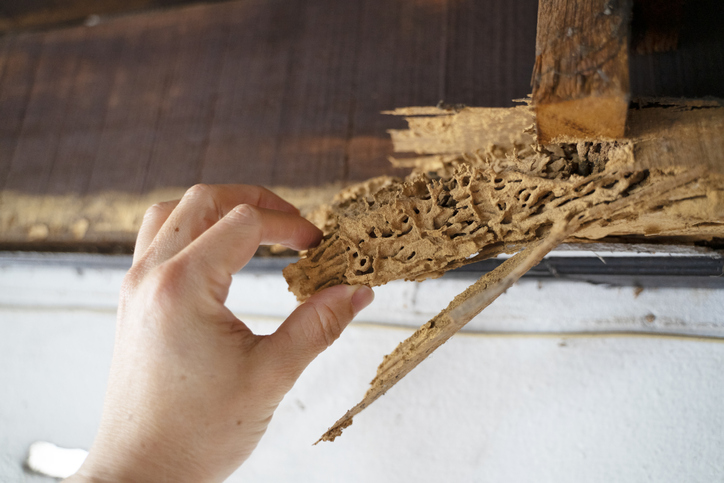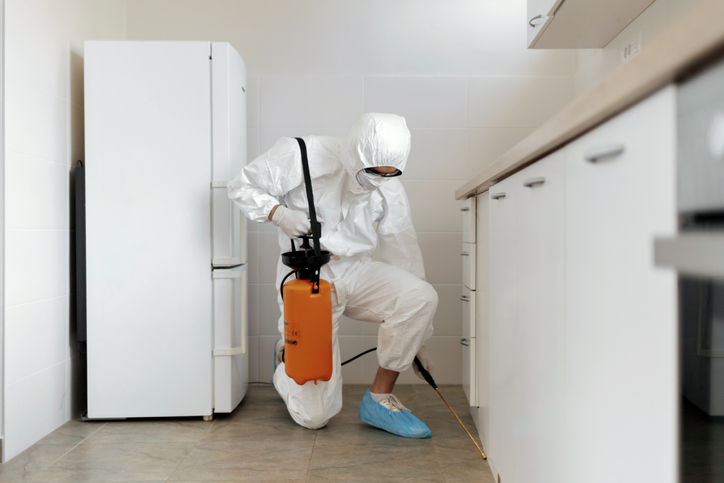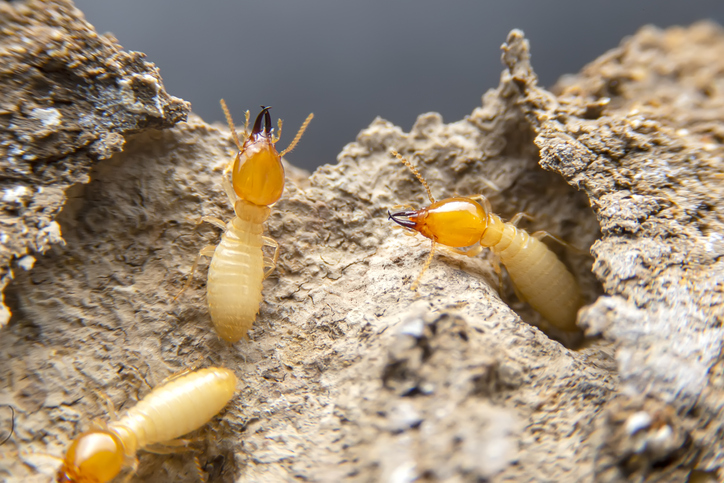Termites are destructive pests that can wreak havoc on buildings and wooden structures. Identifying the early warning signs of a termite infestation is crucial for prompt action and minimizing potential damage. While termites often go unnoticed until significant harm has been done, there are several indicators that can alert homeowners to their presence. These signs include the presence of discarded termite wings, mud tubes, hollow-sounding wood, blistered or sagging floors, and small piles of frass (termite droppings). By recognizing these early warning signs, individuals can take timely measures to address the infestation, engage professional pest control services, and protect their property from further termite damage.

Potential Damage Caused By Unchecked Termite Infestation
If termite infestations are left unchecked, they can cause significant damage to homes and buildings. Termites primarily feed on the wooden components of a structure, including beams, support posts, flooring, and even furniture. Over time, the continuous feeding and tunneling activities of termites weaken the structural integrity of the infested wood.
The damage caused by termites may vary depending on the termite species, the size of the colony, and the duration of the infestation. Common signs of termite damage include hollow-sounding wood, sagging floors, buckling or blistered paint, and small holes in wooden surfaces. In severe cases, structural damage can occur, compromising the stability of the building.
Proactive Prevention Measures
Given the potential damage termites can cause, it is crucial for homeowners to take proactive measures to prevent termite infestation. Prevention is more effective and less costly than dealing with the aftermath of an infestation. Some proactive prevention measures include:
- Regular inspections – Conduct periodic inspections of your property to identify early signs of termite activity. Pay attention to wooden structures, crawl spaces, attics, and other vulnerable areas.
- Moisture control – Termites are attracted to moist environments. Ensure proper drainage around the foundation, fix leaks promptly, and reduce moisture buildup in and around your home.
- Wood-to-soil contact – Minimize direct contact between wooden structures and the soil. Use concrete or metal supports to create a barrier and prevent termites from accessing the wood.
- Remove wood debris – Remove decaying wood, tree stumps, and woodpiles from your property as they can attract termites.
- Pre-treatments – If you are constructing a new home or renovating, consider pre-treating the soil or using termite-resistant building materials to deter termites.
By implementing these preventive measures, homeowners can significantly reduce the risk of termite infestation and protect their properties from the destructive impact of these pests. It is also advisable to consult with professional pest control services for expert advice, regular inspections, and appropriate treatment options to safeguard your home against termites.
-
Best OverallSave $50 on your first recurring service today with code GET50
-
Best for TermitesSave $50 on pest control services with code SAVE50 at checkout
-
Best for Bed BugsGet a free estimate on pest control services for your home
-
Best for Wildlife RemovalCall For A Fast & FREE Phone Estimate Today
-
Best for Natural TreatmentGet $100 Off Your Termite Treatment Service
Types Of Termites
Subterranean Termites
Subterranean termites are known for their ability to build elaborate tunnel systems and travel from their nests in the soil to above-ground food sources. They leave behind visible signs of their presence:
- Mud tubes or tunnels on foundation walls or surfaces – Subterranean termites construct mud tubes to create a protected pathway between their colony in the soil and the wood they are infesting. These tubes are typically about the width of a pencil and are made of soil and saliva. They can be found on foundation walls, along the exterior of the building, or even inside basements or crawlspaces.
- Discarded wings near windowsills or light sources – When subterranean termites swarm and establish new colonies, winged reproductive termites, known as swarmers or alates, emerge from the ground. After they find a suitable mate and establish a new colony, they shed their wings. Finding discarded wings near windowsills, light sources, or other areas of the house is a clear indication of subterranean termite activity.
Drywood Termites
Drywood termites infest dry wood directly without the need for contact with soil. They tend to create smaller, localized colonies within the infested wood. Detecting their presence relies on observing the following visual signs:
- Small kick-out holes in wooden surfaces – Drywood termites create small openings in the wood surface, called kick-out holes, through which they discard their fecal pellets, known as frass. These holes are often approximately the size of a pinhead and can be found on furniture, trim, or other wooden surfaces. The presence of these tiny holes is a clear indication of drywood termite activity.
- Piles of termite droppings (frass) resembling sawdust or pellets – Drywood termites produce distinctive fecal pellets that they push out of their galleries through kick-out holes. These pellets can accumulate in small piles beneath infested areas. They resemble sawdust or tiny pellets and may vary in color depending on the wood being consumed. The presence of frass piles is a strong indication of drywood termite infestation.
Dampwood Termites
Dampwood termites are attracted to wood with high moisture content and are commonly found in areas with excessive moisture. Detecting their presence involves looking for the following visual signs:
- Presence of moisture or dampness in wooden structures – Dampwood termites require a moist environment to thrive. If you notice areas of excessive moisture or dampness in wooden structures, such as beams or floors, it can indicate dampwood termite activity. This could be a sign of an underlying moisture issue that should be addressed promptly.
- Hollowed or damaged wood – Dampwood termites excavate galleries within the wood as they feed. This can result in hollowed or damaged wood, which may appear weak or crumble easily when prodded. If you come across wood that appears hollowed out or structurally compromised, it may be an indication of dampwood termite infestation.
It’s important to note that visual signs alone may not provide a conclusive confirmation of termite infestation. If you suspect termite activity based on these indicators, it’s advisable to seek professional inspection and assistance to accurately identify the presence of termites and develop an appropriate treatment plan.
Sounds And Smells Of Termites
While termites are known for their ability to cause extensive damage to wooden structures, they are generally silent pests. Unlike some other pests, such as rodents or cockroaches, termites do not produce audible sounds or distinct odors that can be directly attributed to their presence. Therefore, sound or odor alone is not typically reliable for identifying a termite infestation.
It’s worth mentioning that in certain circumstances, when a termite colony is disturbed or large enough, clicking sounds or rustling noises may be faintly audible. These sounds are produced by soldier termites as a defensive mechanism to communicate or ward off threats. However, these occurrences are relatively rare and not commonly experienced in everyday situations.
Termites Distinctive Odors
Unlike rodents or cockroaches, termites do not produce distinctive odors that are easily detectable. While some people may associate a musty or mildew-like smell with termite infestations, this odor is usually the result of mold or fungal growth, which can thrive in areas with moisture issues caused by termites. Therefore, the odor itself does not directly indicate termite activity, but rather secondary effects associated with moisture or wood decay.
It’s important to note that relying solely on auditory or olfactory indicators can be misleading when it comes to detecting termite infestations. Visual inspection of physical signs and evidence, such as mud tubes, damaged wood, or termite droppings, is a more reliable method to identify the presence of termites. If you suspect a termite infestation, it is recommended to consult with a professional pest control service for a thorough inspection and accurate diagnosis.
Signs Of Termite Activity In Specific Areas
It’s crucial to regularly inspect these specific areas for signs of termite activity. If you notice any of these signs or suspect a termite infestation, it’s recommended to consult with a professional pest control service for a thorough inspection and appropriate treatment.
Termites In Wooden Structures
Wooden structures, such as beams, floors, or support posts, are prime targets for termite infestation. Here are some signs of termite activity to watch for.
- Hollow-sounding or weakened wood – Termites feed on the cellulose within the wood, hollowing it out from the inside. If you tap or knock on wooden structures and they produce a hollow sound or feel weakened, it could indicate termite damage.
- Intricate tunnel patterns – Termites create intricate tunnels within the wood as they feed and travel through galleries. These tunnels may not be visible from the surface, but if you find damaged wood that reveals maze-like patterns upon closer inspection, it suggests termite activity.
Termite Signs In Walls, Drywall, And Plaster
While termites primarily target wood, they can also infest walls, drywall, or plaster if there is direct contact with wood. Look for the following signs:
- Bubbling or uneven paint – Termite activity within walls can cause paint to bubble, peel, or appear uneven. This occurs as termites create tunnels behind the wall, causing the paint to lose adhesion.
- Small holes or cracks – Termites may create small holes or cracks in walls as they construct tunnels or search for food sources. These openings can be an entry point for termites and a visible sign of infestation.
Termites In Attic And Crawlspaces
Attics and crawlspaces provide favorable conditions for termites. Inspect these areas for the following indications:
- Mud tubes along walls or beams – Subterranean termites, in particular, construct mud tubes as protective tunnels from the ground to above-ground sources of wood. If you observe mud tubes along walls, beams, or other surfaces in the attic or crawlspace, it suggests termite infestation.
- Damaged or hollow-sounding wooden beams – Termites can weaken wooden beams in attics or crawlspaces. If beams appear damaged or produce a hollow sound when tapped, it indicates potential termite activity.
Furniture And Stored Items
Termites can infest wooden furniture or items stored in areas susceptible to termite activity. Watch for the following signs:
- Small holes or tunnels on wooden furniture – Inspect wooden furniture for small holes or tunnels created by termites. These may be present on the surface or hidden in crevices and joints.
- Presence of termite droppings (frass) – Termite droppings, also known as frass, resemble sawdust or tiny pellets. If you find small piles of frass near wooden furniture, it suggests active termite feeding.
Infestation In Garden Or Yard
Termites can also affect outdoor structures and plants. Termites can construct mud tubes on trees, stumps, or fences to access above-ground wood. Check for the presence of these tubes as an indication of termite activity. During the reproductive stage, termites swarm to mate and establish new colonies. Discarded wings or swarmers near outdoor light sources, such as porch lights or windows, are signs of a termite swarm and potential infestation.
-
Best OverallSave $50 on your first recurring service today with code GET50
-
Best for TermitesSave $50 on pest control services with code SAVE50 at checkout
-
Best for Bed BugsGet a free estimate on pest control services for your home
-
Best for Wildlife RemovalCall For A Fast & FREE Phone Estimate Today
-
Best for Natural TreatmentGet $100 Off Your Termite Treatment Service
Differentiating Termite Damage From Other Factors
Differentiating between termite damage and damage caused by other factors can be challenging. If you are unsure about the cause of the damage or suspect termite infestation, it is recommended to consult with a professional pest control service. They can conduct a thorough inspection, identify the source of the damage, and provide appropriate treatment options.
Distinguishing Termite Damage From Damage Caused By Other Factors
When assessing potential damage in a structure, it is important to differentiate termite damage from damage caused by other factors. Here are some key factors to consider:
- Location and patterns – Termite damage often exhibits patterns such as intricate tunnels or galleries within the wood. It tends to be concentrated in specific areas where termites have been actively feeding. In contrast, damage from other factors may appear more random or localized.
- Material preference – Termites primarily target wood and cellulose-based materials. If the damage is limited to these materials, it is more likely to be caused by termites. Other factors may damage a wider range of materials.
- Visual signs – Look for specific visual signs associated with termite damage, such as mud tubes, termite droppings (frass), or discarded wings. These signs are typically unique to termite infestations.
Moisture Damage
Moisture damage can sometimes be mistaken for termite damage. Consider the following indicators of moisture-related issues:
- Water stains or discoloration – Water leaks or excessive moisture can lead to stains or discoloration on walls, ceilings, or wooden surfaces. These stains may appear dark, discolored, or have a water-like appearance.
- Sagging or warping of wood – Prolonged exposure to moisture can cause wood to lose its structural integrity. It may sag, warp, or become distorted. This type of damage is more likely to occur in areas with high humidity or water exposure.
Wood Decay
Wood decay caused by fungal growth or mold can resemble termite damage. Wood affected by fungal growth or mold may have visible patches of discoloration, powdery substances, or fuzzy textures. This type of damage is often accompanied by a musty odor. As decay progresses, wood affected by fungal growth becomes soft, spongy, or crumbles easily when touched. It may lose its structural strength.
Other Pests
Damage caused by other pests may share similarities with termite damage. Consider the following indicators of damage caused by other pests:
- Insect droppings or excrement – Different pests may leave behind distinct droppings or excrement. For example, rodent droppings tend to be larger and cylindrical, while cockroach droppings resemble small, black grains.
- Evidence of chewing or gnawing – Some pests, such as rodents, exhibit distinct gnaw marks on wood or other materials. These marks may appear as rough edges or indentations.
Preventive Measures And Early Intervention Of Termites
Implementing preventive measures, conducting regular inspections, promptly addressing moisture issues, removing wood debris, and seeking professional assistance are crucial steps to reduce the risk of termite infestations and protect your property. Taking these proactive measures and intervening at the earliest signs of termite activity can save homeowners from extensive damage and costly repairs.
Importance Of Preventive Measures To Reduce Termite Infestation Risk
Taking proactive measures to prevent termite infestation is crucial in safeguarding your home and minimizing the potential damage caused by these destructive pests. Implementing preventive measures can significantly reduce the risk of termite infestations and save homeowners from costly repairs. By being proactive, you can create an environment that is less attractive to termites and make it more difficult for them to establish colonies.
Practical Tips For Homeowners
- Regular inspection of wooden structures – Conduct regular inspections of wooden structures in and around your home. Look for signs of termite activity, such as mud tubes, damaged wood, or termite droppings. Pay attention to vulnerable areas such as foundations, attics, basements, crawlspaces, and wooden furniture. Early detection is key to preventing termite infestations from progressing.
- Promptly addressing moisture issues – Termites thrive in moist environments. Fix any plumbing leaks, ensure proper drainage away from the foundation, and keep gutters clean to prevent water accumulation. By reducing moisture levels, you create an environment that is less favorable for termites to thrive.
- Removing wood debris and minimizing soil contact – Termites are attracted to wood debris, such as fallen trees, tree stumps, or woodpiles. Remove any decaying wood or wood debris near your home, as they serve as potential food sources and nesting sites. Additionally, minimize direct contact between wooden structures (e.g., decks, fences) and the soil. Use concrete or metal supports to create a physical barrier that termites cannot easily breach.
- Seeking professional pest control services – Consulting with professional pest control services is highly recommended for effective termite prevention. Pest control professionals have the expertise, tools, and resources to identify potential risks, conduct thorough inspections, and implement targeted preventive treatments. They can develop a tailored plan based on your specific situation to protect your home from termites.
Significance Of Early Intervention And Professional Assistance
Early intervention is crucial in mitigating the potential damage caused by termites. Detecting termite infestations at an early stage allows for prompt treatment and prevention of further damage. The longer an infestation goes undetected, the more time termites have to multiply and cause structural harm. Therefore, regular inspections and vigilance are essential.
Professional assistance is vital in dealing with termite infestations effectively. Pest control professionals have the knowledge and experience to identify signs of termite activity that may go unnoticed by homeowners. They can provide targeted treatment options, such as termiticide applications or bait systems, to eliminate existing infestations and prevent future ones. Professional intervention ensures that the appropriate techniques are used safely and effectively, providing long-term protection for your home.
Conclusion
Early detection of termite infestation is paramount in minimizing the damage termites can cause to your home. By identifying signs of termite activity at an early stage, you can take prompt action to eliminate the infestation and prevent further destruction. Termites work silently and can cause extensive structural damage over time if left unchecked. Early detection allows for targeted treatment, which is often more effective and less costly than dealing with severe infestations. Therefore, being vigilant and proactive in identifying signs of termite activity is essential for protecting your home. By taking preventive actions, and seeking expert assistance, you can ensure the long-term safety and integrity of your property. Remember, prevention is always better than dealing with the aftermath of a severe termite infestation.









